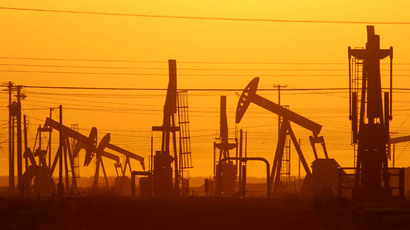11 earthquakes hit fracking-heavy central Oklahoma over weekend

Eleven minor earthquakes shook central Oklahoma over the weekend, renewing speculation that the area’s oil and gas drilling boom - fueled by controversial hydraulic fracturing, or fracking - is to blame for an increase in seismic activity.
During a 14-hour stretch from Saturday evening to Sunday morning, the US Geological Survey recorded seven quakes ranging from magnitude 2.6 to 2.9 in areas northeast of Oklahoma City.
In addition, a 4.3-magnitude temblor hit Langston just after noon on Saturday, and three other quakes ranging from magnitude 2.9 to 3.2 occurred Saturday morning.
There were no reports of major damage or injuries, according to Tulsa World.
Mounting scientific evidence has linked an uptick in seismic activity in states like Oklahoma to fracking developments amid the current domestic energy boom.
While scientists are careful not to rule out natural causes, many researchers believe injection wells used to dispose of hydraulic fracking wastewater contribute to heightened earthquake activity. To unleash oil or natural gas, fracking requires blasting large volumes of highly pressurized water, sand, and other chemicals into layers of rock.
Scientists attending the recent Seismological Society of America (SSA) annual meeting in May said that the storage of toxic drilling wastewater in wells deep below the earth’s surface, in addition to fracking’s other processes, is changing the stress on existing faults, which could mean more frequent and larger quakes in the future.
The last five years have seen Oklahoma experience more than 2,500 earthquakes, the majority of which are associated with drilling maneuvers like fracking, according to a recent study. Researchers found that fracking could also be responsible for earthquakes occurring nearly 20 miles away from drilling and waste deposit sites.
According to Scientific American, Oklahoma has seen more than 230 earthquakes registering magnitudes of 3.0 or higher in this year alone. Before 2008, the state only averaged one of these earthquakes a year.
In a report published earlier this month by the journal Science, researchers from Cornell University and the University of Colorado found that roughly 20 percent of all the earthquakes that occurred in the central and eastern United States were caused by activity at just four fracking wells situated near the town of Jones, Oklahoma.
Fracking has also been linked with groundwater contamination, exacerbation of drought conditions, and a host of health concerns for humans and the local environment.
According to Tulsa World, government regulators and research geologists met with residents in Edmond, Oklahoma last month, where many locals called for restrictions and even bans on wastewater wells.
Research seismologist Austin Holland, of the Oklahoma Geological Survey, said at the meeting that his agency is closely monitoring the quakes and their causes. He said though similar drilling methods have been used in the state in years past, but seismic activity did not reach a level of concern for researchers until 2009.














